APT6000: Counseling Intervention & Treatment Plan for Childhood CSA
VerifiedAdded on 2023/03/31
|11
|2659
|154
Case Study
AI Summary
This case study presents a treatment plan and counseling intervention for a 32-year-old woman, Sam, who experienced childhood sexual abuse (CSA) by her stepbrother. The primary concern is Sam's anxiety and distress related to seeing her abuser at her stepsister's wedding. The proposed treatment involves Cognitive Processing Therapy (CPT) to address maladaptive beliefs and trauma-related issues. The plan outlines six initial sessions focusing on understanding the impact of trauma, identifying stuck points, challenging negative thoughts, and developing alternative perspectives. The case study also discusses the potential use of Dialectical Behavior Therapy (DBT) to improve self-confidence, manage anger, and enhance self-awareness. Potential challenges related to PTSD and the patient's mental state are also considered.

Running head: TREATMENT PLAN AND COUNSELING INTERVENTION
1
Treatment Plan and Counseling Intervention
Student’s Name
Institutional Affiliation
1
Treatment Plan and Counseling Intervention
Student’s Name
Institutional Affiliation
Paraphrase This Document
Need a fresh take? Get an instant paraphrase of this document with our AI Paraphraser
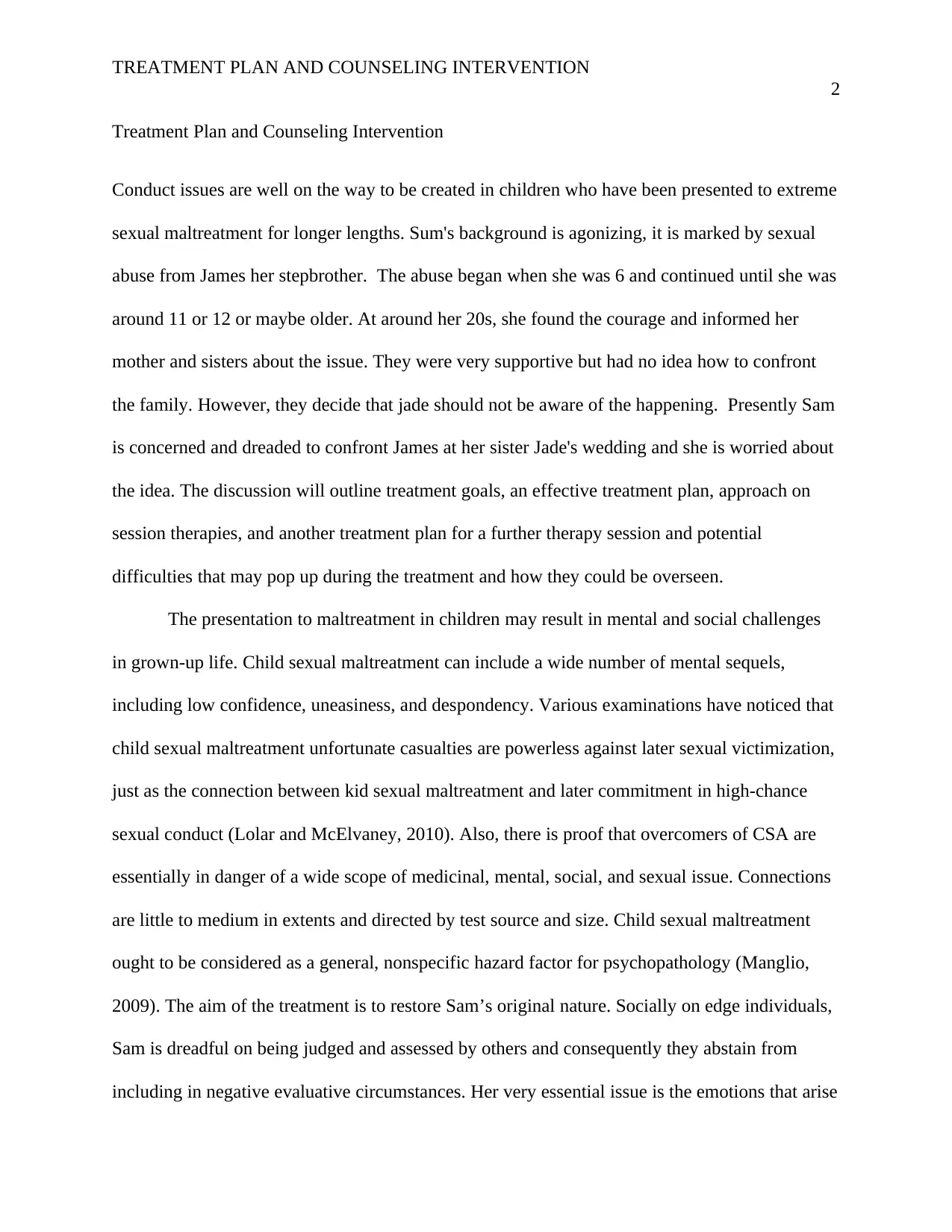
TREATMENT PLAN AND COUNSELING INTERVENTION
2
Treatment Plan and Counseling Intervention
Conduct issues are well on the way to be created in children who have been presented to extreme
sexual maltreatment for longer lengths. Sum's background is agonizing, it is marked by sexual
abuse from James her stepbrother. The abuse began when she was 6 and continued until she was
around 11 or 12 or maybe older. At around her 20s, she found the courage and informed her
mother and sisters about the issue. They were very supportive but had no idea how to confront
the family. However, they decide that jade should not be aware of the happening. Presently Sam
is concerned and dreaded to confront James at her sister Jade's wedding and she is worried about
the idea. The discussion will outline treatment goals, an effective treatment plan, approach on
session therapies, and another treatment plan for a further therapy session and potential
difficulties that may pop up during the treatment and how they could be overseen.
The presentation to maltreatment in children may result in mental and social challenges
in grown-up life. Child sexual maltreatment can include a wide number of mental sequels,
including low confidence, uneasiness, and despondency. Various examinations have noticed that
child sexual maltreatment unfortunate casualties are powerless against later sexual victimization,
just as the connection between kid sexual maltreatment and later commitment in high-chance
sexual conduct (Lolar and McElvaney, 2010). Also, there is proof that overcomers of CSA are
essentially in danger of a wide scope of medicinal, mental, social, and sexual issue. Connections
are little to medium in extents and directed by test source and size. Child sexual maltreatment
ought to be considered as a general, nonspecific hazard factor for psychopathology (Manglio,
2009). The aim of the treatment is to restore Sam’s original nature. Socially on edge individuals,
Sam is dreadful on being judged and assessed by others and consequently they abstain from
including in negative evaluative circumstances. Her very essential issue is the emotions that arise
2
Treatment Plan and Counseling Intervention
Conduct issues are well on the way to be created in children who have been presented to extreme
sexual maltreatment for longer lengths. Sum's background is agonizing, it is marked by sexual
abuse from James her stepbrother. The abuse began when she was 6 and continued until she was
around 11 or 12 or maybe older. At around her 20s, she found the courage and informed her
mother and sisters about the issue. They were very supportive but had no idea how to confront
the family. However, they decide that jade should not be aware of the happening. Presently Sam
is concerned and dreaded to confront James at her sister Jade's wedding and she is worried about
the idea. The discussion will outline treatment goals, an effective treatment plan, approach on
session therapies, and another treatment plan for a further therapy session and potential
difficulties that may pop up during the treatment and how they could be overseen.
The presentation to maltreatment in children may result in mental and social challenges
in grown-up life. Child sexual maltreatment can include a wide number of mental sequels,
including low confidence, uneasiness, and despondency. Various examinations have noticed that
child sexual maltreatment unfortunate casualties are powerless against later sexual victimization,
just as the connection between kid sexual maltreatment and later commitment in high-chance
sexual conduct (Lolar and McElvaney, 2010). Also, there is proof that overcomers of CSA are
essentially in danger of a wide scope of medicinal, mental, social, and sexual issue. Connections
are little to medium in extents and directed by test source and size. Child sexual maltreatment
ought to be considered as a general, nonspecific hazard factor for psychopathology (Manglio,
2009). The aim of the treatment is to restore Sam’s original nature. Socially on edge individuals,
Sam is dreadful on being judged and assessed by others and consequently they abstain from
including in negative evaluative circumstances. Her very essential issue is the emotions that arise
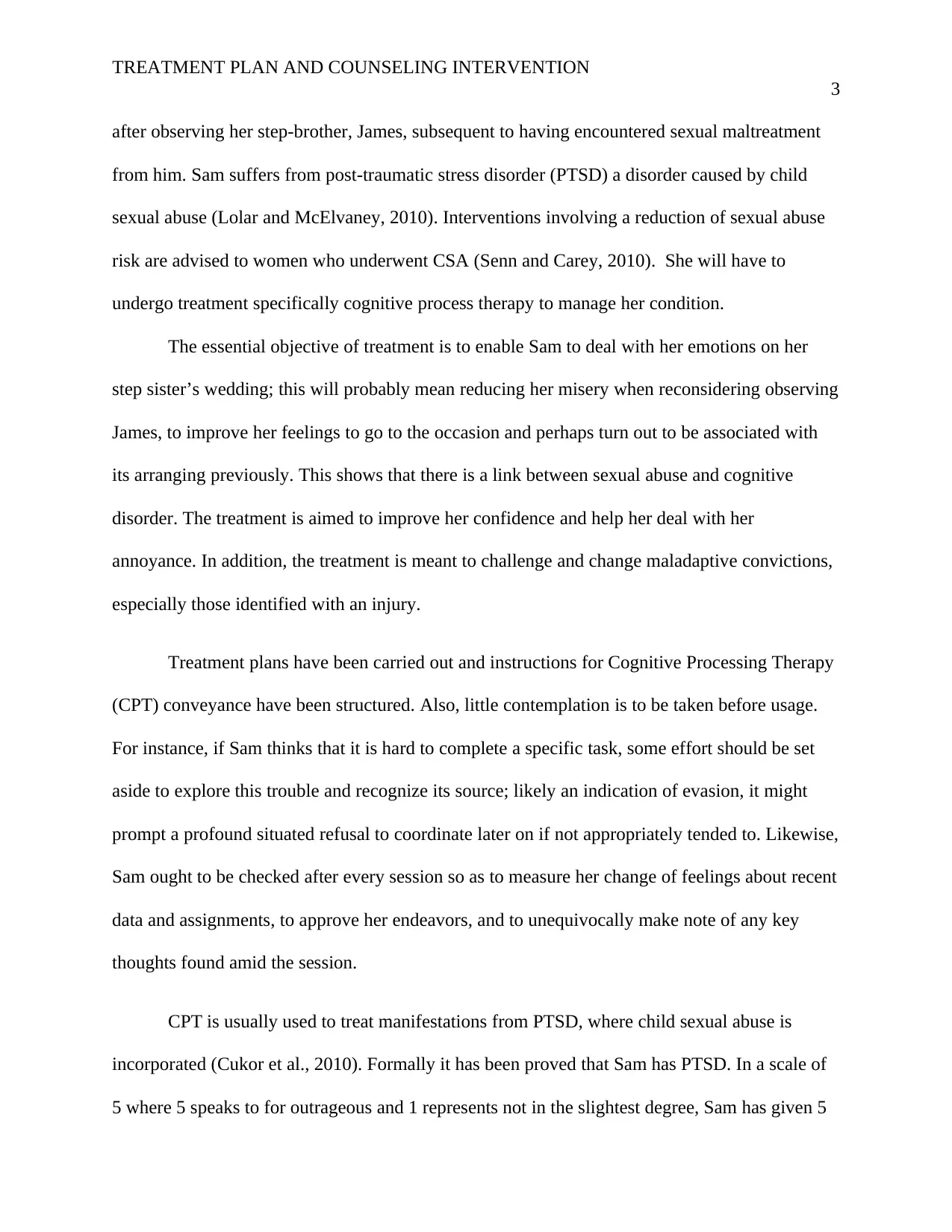
TREATMENT PLAN AND COUNSELING INTERVENTION
3
after observing her step-brother, James, subsequent to having encountered sexual maltreatment
from him. Sam suffers from post-traumatic stress disorder (PTSD) a disorder caused by child
sexual abuse (Lolar and McElvaney, 2010). Interventions involving a reduction of sexual abuse
risk are advised to women who underwent CSA (Senn and Carey, 2010). She will have to
undergo treatment specifically cognitive process therapy to manage her condition.
The essential objective of treatment is to enable Sam to deal with her emotions on her
step sister’s wedding; this will probably mean reducing her misery when reconsidering observing
James, to improve her feelings to go to the occasion and perhaps turn out to be associated with
its arranging previously. This shows that there is a link between sexual abuse and cognitive
disorder. The treatment is aimed to improve her confidence and help her deal with her
annoyance. In addition, the treatment is meant to challenge and change maladaptive convictions,
especially those identified with an injury.
Treatment plans have been carried out and instructions for Cognitive Processing Therapy
(CPT) conveyance have been structured. Also, little contemplation is to be taken before usage.
For instance, if Sam thinks that it is hard to complete a specific task, some effort should be set
aside to explore this trouble and recognize its source; likely an indication of evasion, it might
prompt a profound situated refusal to coordinate later on if not appropriately tended to. Likewise,
Sam ought to be checked after every session so as to measure her change of feelings about recent
data and assignments, to approve her endeavors, and to unequivocally make note of any key
thoughts found amid the session.
CPT is usually used to treat manifestations from PTSD, where child sexual abuse is
incorporated (Cukor et al., 2010). Formally it has been proved that Sam has PTSD. In a scale of
5 where 5 speaks to for outrageous and 1 represents not in the slightest degree, Sam has given 5
3
after observing her step-brother, James, subsequent to having encountered sexual maltreatment
from him. Sam suffers from post-traumatic stress disorder (PTSD) a disorder caused by child
sexual abuse (Lolar and McElvaney, 2010). Interventions involving a reduction of sexual abuse
risk are advised to women who underwent CSA (Senn and Carey, 2010). She will have to
undergo treatment specifically cognitive process therapy to manage her condition.
The essential objective of treatment is to enable Sam to deal with her emotions on her
step sister’s wedding; this will probably mean reducing her misery when reconsidering observing
James, to improve her feelings to go to the occasion and perhaps turn out to be associated with
its arranging previously. This shows that there is a link between sexual abuse and cognitive
disorder. The treatment is aimed to improve her confidence and help her deal with her
annoyance. In addition, the treatment is meant to challenge and change maladaptive convictions,
especially those identified with an injury.
Treatment plans have been carried out and instructions for Cognitive Processing Therapy
(CPT) conveyance have been structured. Also, little contemplation is to be taken before usage.
For instance, if Sam thinks that it is hard to complete a specific task, some effort should be set
aside to explore this trouble and recognize its source; likely an indication of evasion, it might
prompt a profound situated refusal to coordinate later on if not appropriately tended to. Likewise,
Sam ought to be checked after every session so as to measure her change of feelings about recent
data and assignments, to approve her endeavors, and to unequivocally make note of any key
thoughts found amid the session.
CPT is usually used to treat manifestations from PTSD, where child sexual abuse is
incorporated (Cukor et al., 2010). Formally it has been proved that Sam has PTSD. In a scale of
5 where 5 speaks to for outrageous and 1 represents not in the slightest degree, Sam has given 5
⊘ This is a preview!⊘
Do you want full access?
Subscribe today to unlock all pages.

Trusted by 1+ million students worldwide
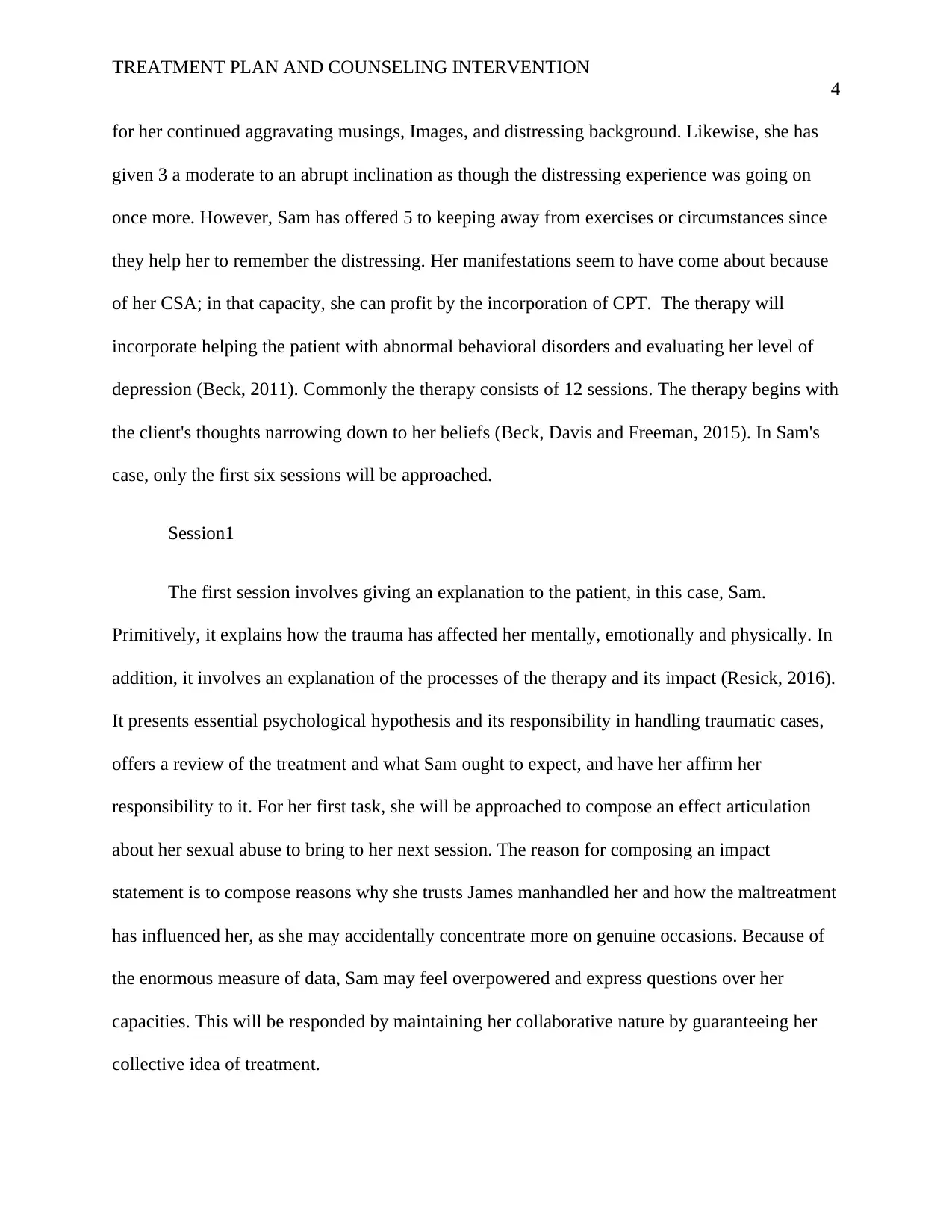
TREATMENT PLAN AND COUNSELING INTERVENTION
4
for her continued aggravating musings, Images, and distressing background. Likewise, she has
given 3 a moderate to an abrupt inclination as though the distressing experience was going on
once more. However, Sam has offered 5 to keeping away from exercises or circumstances since
they help her to remember the distressing. Her manifestations seem to have come about because
of her CSA; in that capacity, she can profit by the incorporation of CPT. The therapy will
incorporate helping the patient with abnormal behavioral disorders and evaluating her level of
depression (Beck, 2011). Commonly the therapy consists of 12 sessions. The therapy begins with
the client's thoughts narrowing down to her beliefs (Beck, Davis and Freeman, 2015). In Sam's
case, only the first six sessions will be approached.
Session1
The first session involves giving an explanation to the patient, in this case, Sam.
Primitively, it explains how the trauma has affected her mentally, emotionally and physically. In
addition, it involves an explanation of the processes of the therapy and its impact (Resick, 2016).
It presents essential psychological hypothesis and its responsibility in handling traumatic cases,
offers a review of the treatment and what Sam ought to expect, and have her affirm her
responsibility to it. For her first task, she will be approached to compose an effect articulation
about her sexual abuse to bring to her next session. The reason for composing an impact
statement is to compose reasons why she trusts James manhandled her and how the maltreatment
has influenced her, as she may accidentally concentrate more on genuine occasions. Because of
the enormous measure of data, Sam may feel overpowered and express questions over her
capacities. This will be responded by maintaining her collaborative nature by guaranteeing her
collective idea of treatment.
4
for her continued aggravating musings, Images, and distressing background. Likewise, she has
given 3 a moderate to an abrupt inclination as though the distressing experience was going on
once more. However, Sam has offered 5 to keeping away from exercises or circumstances since
they help her to remember the distressing. Her manifestations seem to have come about because
of her CSA; in that capacity, she can profit by the incorporation of CPT. The therapy will
incorporate helping the patient with abnormal behavioral disorders and evaluating her level of
depression (Beck, 2011). Commonly the therapy consists of 12 sessions. The therapy begins with
the client's thoughts narrowing down to her beliefs (Beck, Davis and Freeman, 2015). In Sam's
case, only the first six sessions will be approached.
Session1
The first session involves giving an explanation to the patient, in this case, Sam.
Primitively, it explains how the trauma has affected her mentally, emotionally and physically. In
addition, it involves an explanation of the processes of the therapy and its impact (Resick, 2016).
It presents essential psychological hypothesis and its responsibility in handling traumatic cases,
offers a review of the treatment and what Sam ought to expect, and have her affirm her
responsibility to it. For her first task, she will be approached to compose an effect articulation
about her sexual abuse to bring to her next session. The reason for composing an impact
statement is to compose reasons why she trusts James manhandled her and how the maltreatment
has influenced her, as she may accidentally concentrate more on genuine occasions. Because of
the enormous measure of data, Sam may feel overpowered and express questions over her
capacities. This will be responded by maintaining her collaborative nature by guaranteeing her
collective idea of treatment.
Paraphrase This Document
Need a fresh take? Get an instant paraphrase of this document with our AI Paraphraser
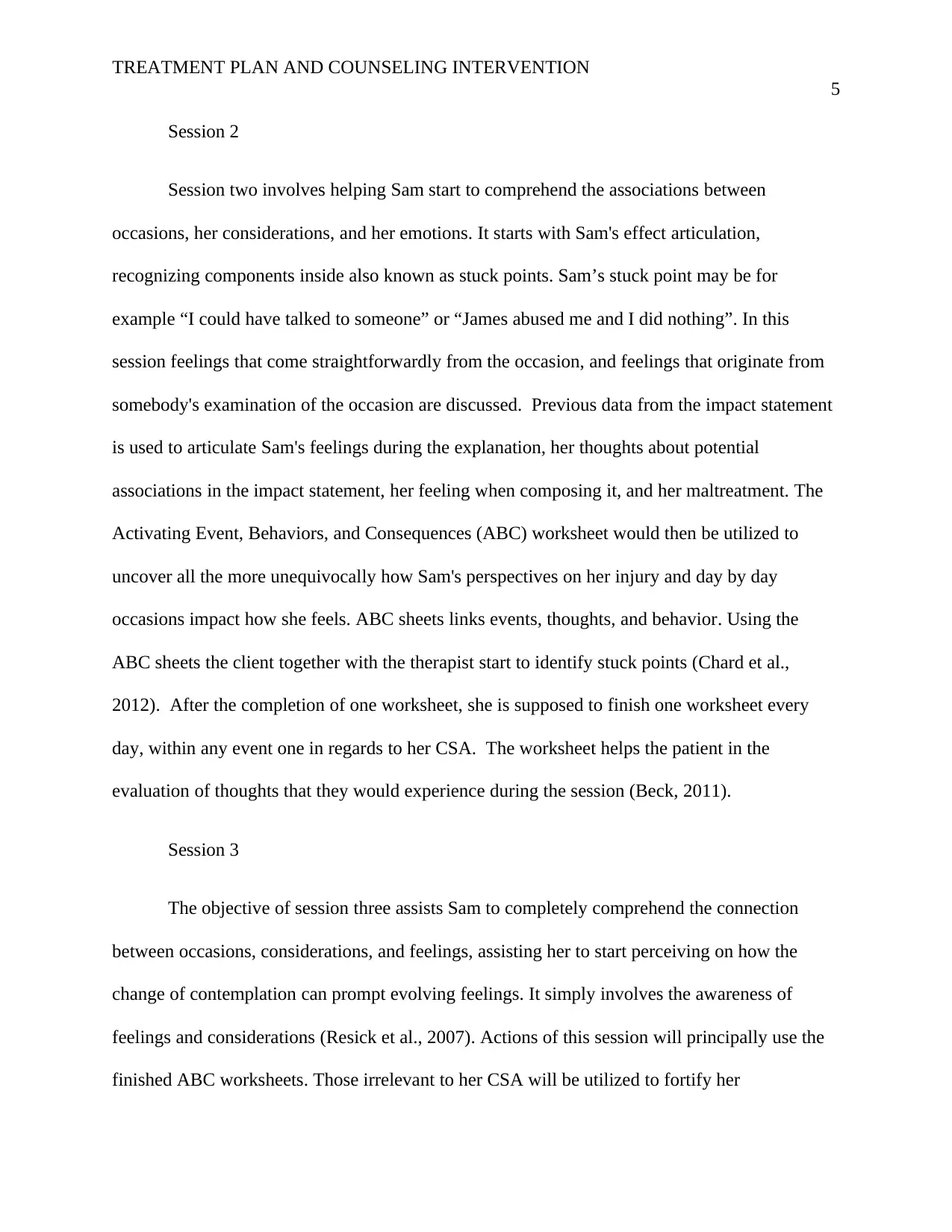
TREATMENT PLAN AND COUNSELING INTERVENTION
5
Session 2
Session two involves helping Sam start to comprehend the associations between
occasions, her considerations, and her emotions. It starts with Sam's effect articulation,
recognizing components inside also known as stuck points. Sam’s stuck point may be for
example “I could have talked to someone” or “James abused me and I did nothing”. In this
session feelings that come straightforwardly from the occasion, and feelings that originate from
somebody's examination of the occasion are discussed. Previous data from the impact statement
is used to articulate Sam's feelings during the explanation, her thoughts about potential
associations in the impact statement, her feeling when composing it, and her maltreatment. The
Activating Event, Behaviors, and Consequences (ABC) worksheet would then be utilized to
uncover all the more unequivocally how Sam's perspectives on her injury and day by day
occasions impact how she feels. ABC sheets links events, thoughts, and behavior. Using the
ABC sheets the client together with the therapist start to identify stuck points (Chard et al.,
2012). After the completion of one worksheet, she is supposed to finish one worksheet every
day, within any event one in regards to her CSA. The worksheet helps the patient in the
evaluation of thoughts that they would experience during the session (Beck, 2011).
Session 3
The objective of session three assists Sam to completely comprehend the connection
between occasions, considerations, and feelings, assisting her to start perceiving on how the
change of contemplation can prompt evolving feelings. It simply involves the awareness of
feelings and considerations (Resick et al., 2007). Actions of this session will principally use the
finished ABC worksheets. Those irrelevant to her CSA will be utilized to fortify her
5
Session 2
Session two involves helping Sam start to comprehend the associations between
occasions, her considerations, and her emotions. It starts with Sam's effect articulation,
recognizing components inside also known as stuck points. Sam’s stuck point may be for
example “I could have talked to someone” or “James abused me and I did nothing”. In this
session feelings that come straightforwardly from the occasion, and feelings that originate from
somebody's examination of the occasion are discussed. Previous data from the impact statement
is used to articulate Sam's feelings during the explanation, her thoughts about potential
associations in the impact statement, her feeling when composing it, and her maltreatment. The
Activating Event, Behaviors, and Consequences (ABC) worksheet would then be utilized to
uncover all the more unequivocally how Sam's perspectives on her injury and day by day
occasions impact how she feels. ABC sheets links events, thoughts, and behavior. Using the
ABC sheets the client together with the therapist start to identify stuck points (Chard et al.,
2012). After the completion of one worksheet, she is supposed to finish one worksheet every
day, within any event one in regards to her CSA. The worksheet helps the patient in the
evaluation of thoughts that they would experience during the session (Beck, 2011).
Session 3
The objective of session three assists Sam to completely comprehend the connection
between occasions, considerations, and feelings, assisting her to start perceiving on how the
change of contemplation can prompt evolving feelings. It simply involves the awareness of
feelings and considerations (Resick et al., 2007). Actions of this session will principally use the
finished ABC worksheets. Those irrelevant to her CSA will be utilized to fortify her

TREATMENT PLAN AND COUNSELING INTERVENTION
6
comprehension of their ideas. On the off chance that she would have finished more worksheet
about her sexual abuse, use of Socratic addressing to inspect an idea from one of the worksheets
would be advised till a conceivable elective idea is produced. Those feelings that emerge from
the new idea will be gathered together. At this point, Sam is yet to accept or even acknowledge
the elective thoughts, but they will present effectively and offer her increasingly on her life. Her
take away task for this session will be finished increasingly day by day.
Session four
Session four is meant to assist Sam to challenge her considerations and think about her
routine perspectives. The session Involve the audit of her worksheets, distinguishing arising
stuck focuses and elevating more established ones. This session enables the client to explore the
meaning of their traumatic behaviors by filling the worksheet (Chard et al., 2012). Sam has been
occupied with Socratic exchange yet again, presently with a description of her child abuse, to
figure out which parts of it are actualities and which are stuck points, just as which parts reflect
goal, duty, and the unforeseeable. This may enable her to think of her as CSA in a progressive
target way as she separates between what she needed when it started and what she could have
done to control it. Challenging Questions are presented, after which one worksheet is completed.
Testing Questions enables Sam to challenge her contemplations on their condition through
scrutinizing her stuck focuses. This will enable Sam to start to divert a portion of the fault for her
CSA from herself. She will be entrusted to finishing one worksheet for every day in the next
session.
Session five
6
comprehension of their ideas. On the off chance that she would have finished more worksheet
about her sexual abuse, use of Socratic addressing to inspect an idea from one of the worksheets
would be advised till a conceivable elective idea is produced. Those feelings that emerge from
the new idea will be gathered together. At this point, Sam is yet to accept or even acknowledge
the elective thoughts, but they will present effectively and offer her increasingly on her life. Her
take away task for this session will be finished increasingly day by day.
Session four
Session four is meant to assist Sam to challenge her considerations and think about her
routine perspectives. The session Involve the audit of her worksheets, distinguishing arising
stuck focuses and elevating more established ones. This session enables the client to explore the
meaning of their traumatic behaviors by filling the worksheet (Chard et al., 2012). Sam has been
occupied with Socratic exchange yet again, presently with a description of her child abuse, to
figure out which parts of it are actualities and which are stuck points, just as which parts reflect
goal, duty, and the unforeseeable. This may enable her to think of her as CSA in a progressive
target way as she separates between what she needed when it started and what she could have
done to control it. Challenging Questions are presented, after which one worksheet is completed.
Testing Questions enables Sam to challenge her contemplations on their condition through
scrutinizing her stuck focuses. This will enable Sam to start to divert a portion of the fault for her
CSA from herself. She will be entrusted to finishing one worksheet for every day in the next
session.
Session five
⊘ This is a preview!⊘
Do you want full access?
Subscribe today to unlock all pages.

Trusted by 1+ million students worldwide
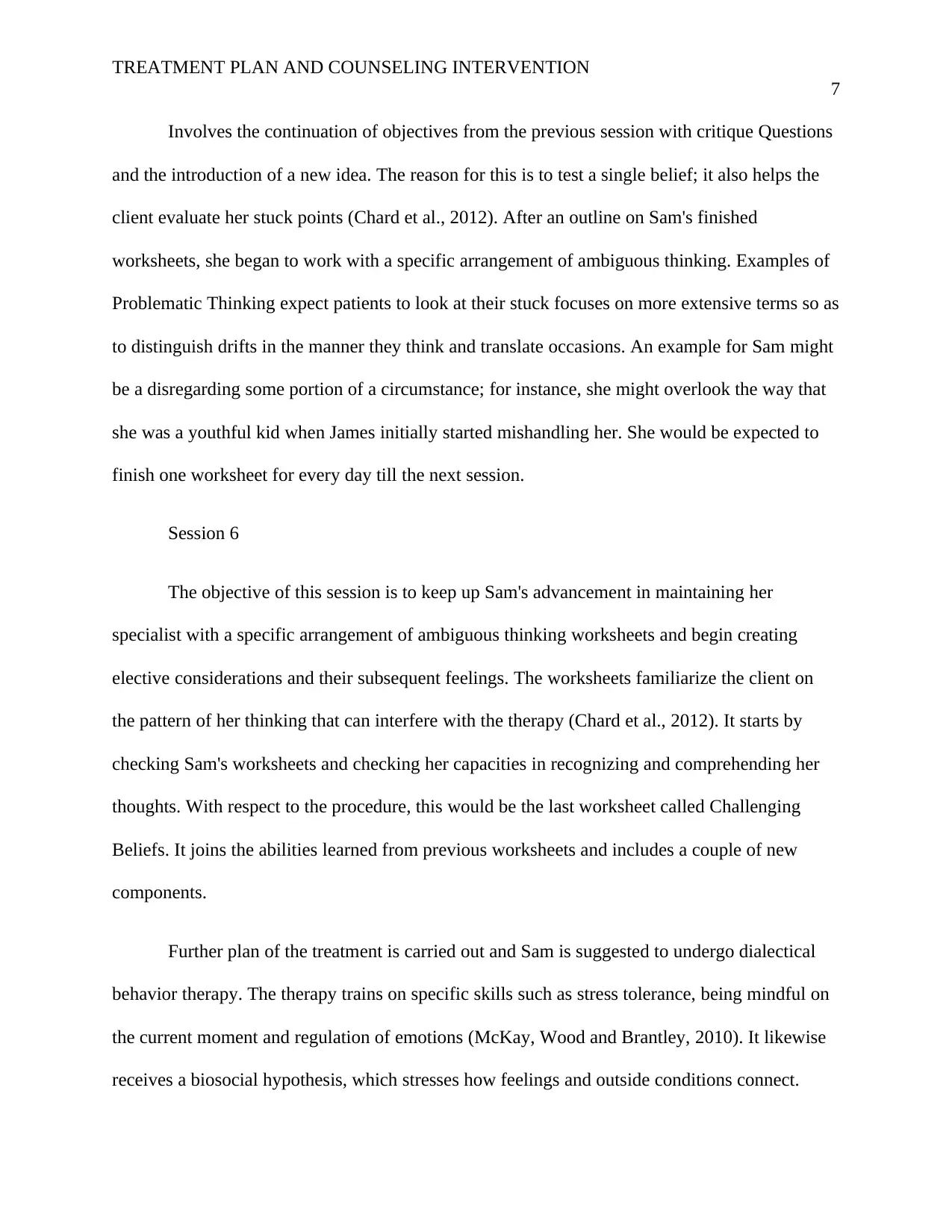
TREATMENT PLAN AND COUNSELING INTERVENTION
7
Involves the continuation of objectives from the previous session with critique Questions
and the introduction of a new idea. The reason for this is to test a single belief; it also helps the
client evaluate her stuck points (Chard et al., 2012). After an outline on Sam's finished
worksheets, she began to work with a specific arrangement of ambiguous thinking. Examples of
Problematic Thinking expect patients to look at their stuck focuses on more extensive terms so as
to distinguish drifts in the manner they think and translate occasions. An example for Sam might
be a disregarding some portion of a circumstance; for instance, she might overlook the way that
she was a youthful kid when James initially started mishandling her. She would be expected to
finish one worksheet for every day till the next session.
Session 6
The objective of this session is to keep up Sam's advancement in maintaining her
specialist with a specific arrangement of ambiguous thinking worksheets and begin creating
elective considerations and their subsequent feelings. The worksheets familiarize the client on
the pattern of her thinking that can interfere with the therapy (Chard et al., 2012). It starts by
checking Sam's worksheets and checking her capacities in recognizing and comprehending her
thoughts. With respect to the procedure, this would be the last worksheet called Challenging
Beliefs. It joins the abilities learned from previous worksheets and includes a couple of new
components.
Further plan of the treatment is carried out and Sam is suggested to undergo dialectical
behavior therapy. The therapy trains on specific skills such as stress tolerance, being mindful on
the current moment and regulation of emotions (McKay, Wood and Brantley, 2010). It likewise
receives a biosocial hypothesis, which stresses how feelings and outside conditions connect.
7
Involves the continuation of objectives from the previous session with critique Questions
and the introduction of a new idea. The reason for this is to test a single belief; it also helps the
client evaluate her stuck points (Chard et al., 2012). After an outline on Sam's finished
worksheets, she began to work with a specific arrangement of ambiguous thinking. Examples of
Problematic Thinking expect patients to look at their stuck focuses on more extensive terms so as
to distinguish drifts in the manner they think and translate occasions. An example for Sam might
be a disregarding some portion of a circumstance; for instance, she might overlook the way that
she was a youthful kid when James initially started mishandling her. She would be expected to
finish one worksheet for every day till the next session.
Session 6
The objective of this session is to keep up Sam's advancement in maintaining her
specialist with a specific arrangement of ambiguous thinking worksheets and begin creating
elective considerations and their subsequent feelings. The worksheets familiarize the client on
the pattern of her thinking that can interfere with the therapy (Chard et al., 2012). It starts by
checking Sam's worksheets and checking her capacities in recognizing and comprehending her
thoughts. With respect to the procedure, this would be the last worksheet called Challenging
Beliefs. It joins the abilities learned from previous worksheets and includes a couple of new
components.
Further plan of the treatment is carried out and Sam is suggested to undergo dialectical
behavior therapy. The therapy trains on specific skills such as stress tolerance, being mindful on
the current moment and regulation of emotions (McKay, Wood and Brantley, 2010). It likewise
receives a biosocial hypothesis, which stresses how feelings and outside conditions connect.
Paraphrase This Document
Need a fresh take? Get an instant paraphrase of this document with our AI Paraphraser
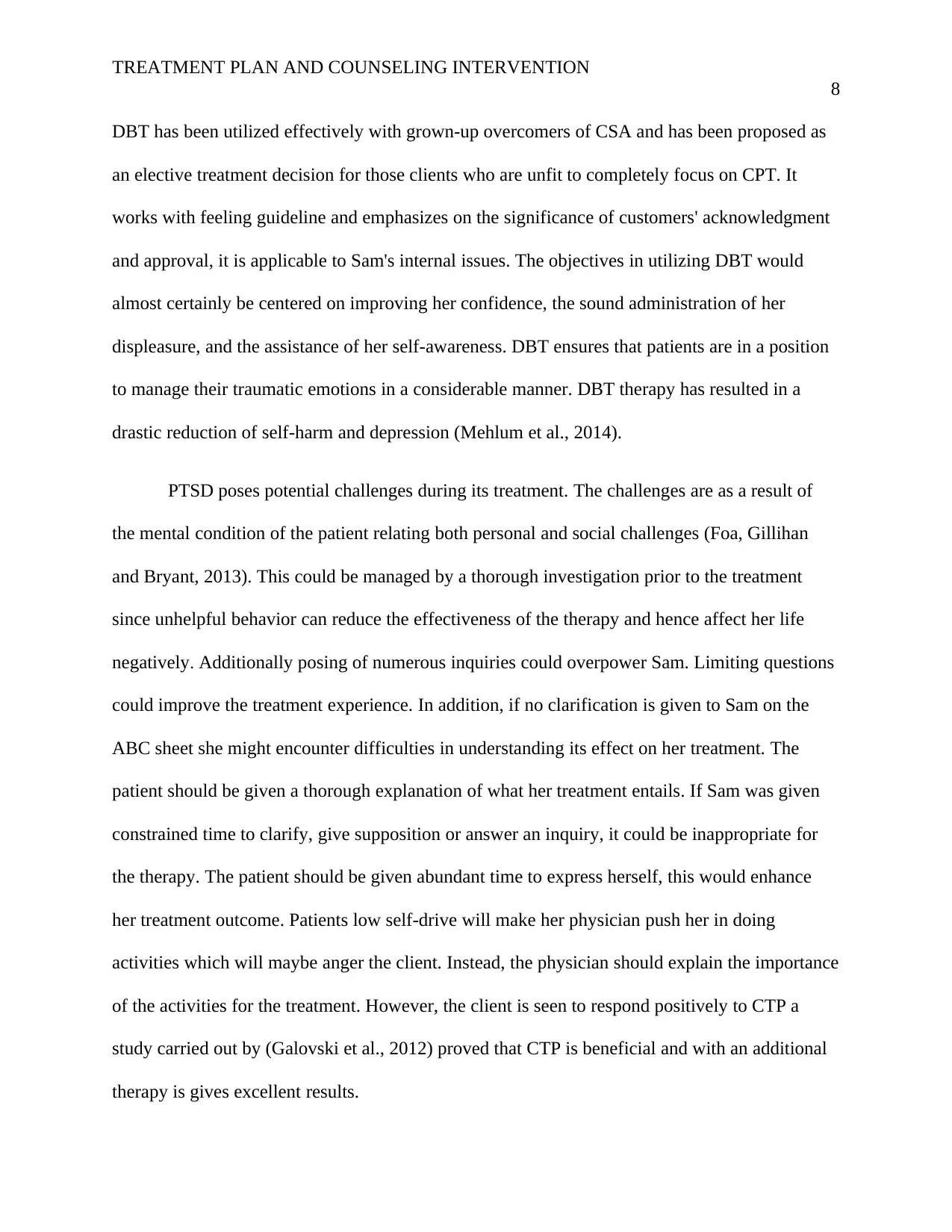
TREATMENT PLAN AND COUNSELING INTERVENTION
8
DBT has been utilized effectively with grown-up overcomers of CSA and has been proposed as
an elective treatment decision for those clients who are unfit to completely focus on CPT. It
works with feeling guideline and emphasizes on the significance of customers' acknowledgment
and approval, it is applicable to Sam's internal issues. The objectives in utilizing DBT would
almost certainly be centered on improving her confidence, the sound administration of her
displeasure, and the assistance of her self-awareness. DBT ensures that patients are in a position
to manage their traumatic emotions in a considerable manner. DBT therapy has resulted in a
drastic reduction of self-harm and depression (Mehlum et al., 2014).
PTSD poses potential challenges during its treatment. The challenges are as a result of
the mental condition of the patient relating both personal and social challenges (Foa, Gillihan
and Bryant, 2013). This could be managed by a thorough investigation prior to the treatment
since unhelpful behavior can reduce the effectiveness of the therapy and hence affect her life
negatively. Additionally posing of numerous inquiries could overpower Sam. Limiting questions
could improve the treatment experience. In addition, if no clarification is given to Sam on the
ABC sheet she might encounter difficulties in understanding its effect on her treatment. The
patient should be given a thorough explanation of what her treatment entails. If Sam was given
constrained time to clarify, give supposition or answer an inquiry, it could be inappropriate for
the therapy. The patient should be given abundant time to express herself, this would enhance
her treatment outcome. Patients low self-drive will make her physician push her in doing
activities which will maybe anger the client. Instead, the physician should explain the importance
of the activities for the treatment. However, the client is seen to respond positively to CTP a
study carried out by (Galovski et al., 2012) proved that CTP is beneficial and with an additional
therapy is gives excellent results.
8
DBT has been utilized effectively with grown-up overcomers of CSA and has been proposed as
an elective treatment decision for those clients who are unfit to completely focus on CPT. It
works with feeling guideline and emphasizes on the significance of customers' acknowledgment
and approval, it is applicable to Sam's internal issues. The objectives in utilizing DBT would
almost certainly be centered on improving her confidence, the sound administration of her
displeasure, and the assistance of her self-awareness. DBT ensures that patients are in a position
to manage their traumatic emotions in a considerable manner. DBT therapy has resulted in a
drastic reduction of self-harm and depression (Mehlum et al., 2014).
PTSD poses potential challenges during its treatment. The challenges are as a result of
the mental condition of the patient relating both personal and social challenges (Foa, Gillihan
and Bryant, 2013). This could be managed by a thorough investigation prior to the treatment
since unhelpful behavior can reduce the effectiveness of the therapy and hence affect her life
negatively. Additionally posing of numerous inquiries could overpower Sam. Limiting questions
could improve the treatment experience. In addition, if no clarification is given to Sam on the
ABC sheet she might encounter difficulties in understanding its effect on her treatment. The
patient should be given a thorough explanation of what her treatment entails. If Sam was given
constrained time to clarify, give supposition or answer an inquiry, it could be inappropriate for
the therapy. The patient should be given abundant time to express herself, this would enhance
her treatment outcome. Patients low self-drive will make her physician push her in doing
activities which will maybe anger the client. Instead, the physician should explain the importance
of the activities for the treatment. However, the client is seen to respond positively to CTP a
study carried out by (Galovski et al., 2012) proved that CTP is beneficial and with an additional
therapy is gives excellent results.

TREATMENT PLAN AND COUNSELING INTERVENTION
9
After the treatment, the patient may compliment the doctor for being calm and for
esteeming her musings and sentiments. She may be astonished by the ABC sheet that showed the
connection between occasion, convictions, practices and how they influence her life. In any case,
the client may feel awkward sooner or later in the session possibly because of numerous
inquiries posed or perhaps the doctor defied her eventually.
Conclusively, parental consideration fabricates flexibility for the individuals who
presented to tyke abuse and could fill in as a defensive factor by relieving the impact of CSA on
the improvement of PTSD.
References
9
After the treatment, the patient may compliment the doctor for being calm and for
esteeming her musings and sentiments. She may be astonished by the ABC sheet that showed the
connection between occasion, convictions, practices and how they influence her life. In any case,
the client may feel awkward sooner or later in the session possibly because of numerous
inquiries posed or perhaps the doctor defied her eventually.
Conclusively, parental consideration fabricates flexibility for the individuals who
presented to tyke abuse and could fill in as a defensive factor by relieving the impact of CSA on
the improvement of PTSD.
References
⊘ This is a preview!⊘
Do you want full access?
Subscribe today to unlock all pages.

Trusted by 1+ million students worldwide
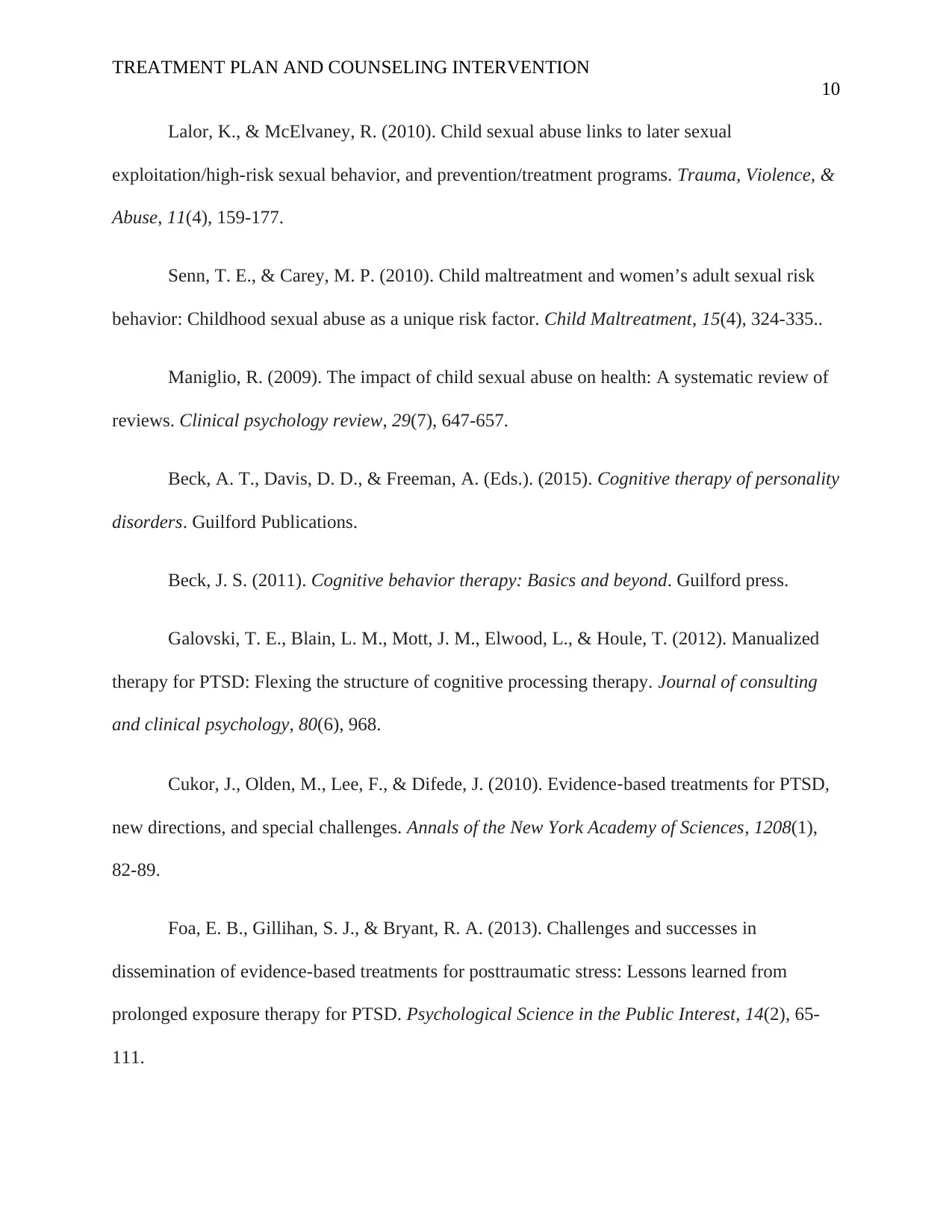
TREATMENT PLAN AND COUNSELING INTERVENTION
10
Lalor, K., & McElvaney, R. (2010). Child sexual abuse links to later sexual
exploitation/high-risk sexual behavior, and prevention/treatment programs. Trauma, Violence, &
Abuse, 11(4), 159-177.
Senn, T. E., & Carey, M. P. (2010). Child maltreatment and women’s adult sexual risk
behavior: Childhood sexual abuse as a unique risk factor. Child Maltreatment, 15(4), 324-335..
Maniglio, R. (2009). The impact of child sexual abuse on health: A systematic review of
reviews. Clinical psychology review, 29(7), 647-657.
Beck, A. T., Davis, D. D., & Freeman, A. (Eds.). (2015). Cognitive therapy of personality
disorders. Guilford Publications.
Beck, J. S. (2011). Cognitive behavior therapy: Basics and beyond. Guilford press.
Galovski, T. E., Blain, L. M., Mott, J. M., Elwood, L., & Houle, T. (2012). Manualized
therapy for PTSD: Flexing the structure of cognitive processing therapy. Journal of consulting
and clinical psychology, 80(6), 968.
Cukor, J., Olden, M., Lee, F., & Difede, J. (2010). Evidence‐based treatments for PTSD,
new directions, and special challenges. Annals of the New York Academy of Sciences, 1208(1),
82-89.
Foa, E. B., Gillihan, S. J., & Bryant, R. A. (2013). Challenges and successes in
dissemination of evidence-based treatments for posttraumatic stress: Lessons learned from
prolonged exposure therapy for PTSD. Psychological Science in the Public Interest, 14(2), 65-
111.
10
Lalor, K., & McElvaney, R. (2010). Child sexual abuse links to later sexual
exploitation/high-risk sexual behavior, and prevention/treatment programs. Trauma, Violence, &
Abuse, 11(4), 159-177.
Senn, T. E., & Carey, M. P. (2010). Child maltreatment and women’s adult sexual risk
behavior: Childhood sexual abuse as a unique risk factor. Child Maltreatment, 15(4), 324-335..
Maniglio, R. (2009). The impact of child sexual abuse on health: A systematic review of
reviews. Clinical psychology review, 29(7), 647-657.
Beck, A. T., Davis, D. D., & Freeman, A. (Eds.). (2015). Cognitive therapy of personality
disorders. Guilford Publications.
Beck, J. S. (2011). Cognitive behavior therapy: Basics and beyond. Guilford press.
Galovski, T. E., Blain, L. M., Mott, J. M., Elwood, L., & Houle, T. (2012). Manualized
therapy for PTSD: Flexing the structure of cognitive processing therapy. Journal of consulting
and clinical psychology, 80(6), 968.
Cukor, J., Olden, M., Lee, F., & Difede, J. (2010). Evidence‐based treatments for PTSD,
new directions, and special challenges. Annals of the New York Academy of Sciences, 1208(1),
82-89.
Foa, E. B., Gillihan, S. J., & Bryant, R. A. (2013). Challenges and successes in
dissemination of evidence-based treatments for posttraumatic stress: Lessons learned from
prolonged exposure therapy for PTSD. Psychological Science in the Public Interest, 14(2), 65-
111.
Paraphrase This Document
Need a fresh take? Get an instant paraphrase of this document with our AI Paraphraser
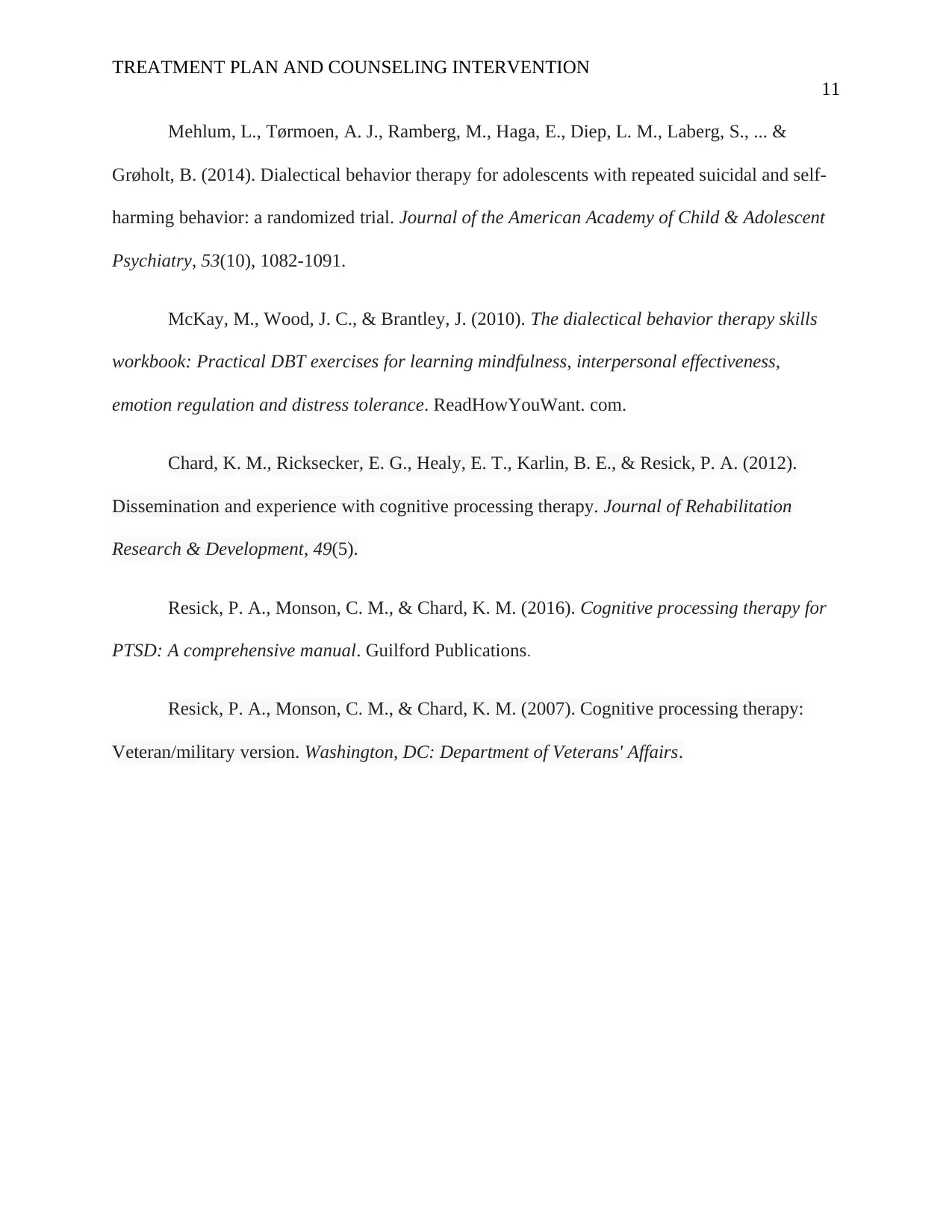
TREATMENT PLAN AND COUNSELING INTERVENTION
11
Mehlum, L., Tørmoen, A. J., Ramberg, M., Haga, E., Diep, L. M., Laberg, S., ... &
Grøholt, B. (2014). Dialectical behavior therapy for adolescents with repeated suicidal and self-
harming behavior: a randomized trial. Journal of the American Academy of Child & Adolescent
Psychiatry, 53(10), 1082-1091.
McKay, M., Wood, J. C., & Brantley, J. (2010). The dialectical behavior therapy skills
workbook: Practical DBT exercises for learning mindfulness, interpersonal effectiveness,
emotion regulation and distress tolerance. ReadHowYouWant. com.
Chard, K. M., Ricksecker, E. G., Healy, E. T., Karlin, B. E., & Resick, P. A. (2012).
Dissemination and experience with cognitive processing therapy. Journal of Rehabilitation
Research & Development, 49(5).
Resick, P. A., Monson, C. M., & Chard, K. M. (2016). Cognitive processing therapy for
PTSD: A comprehensive manual. Guilford Publications.
Resick, P. A., Monson, C. M., & Chard, K. M. (2007). Cognitive processing therapy:
Veteran/military version. Washington, DC: Department of Veterans' Affairs.
11
Mehlum, L., Tørmoen, A. J., Ramberg, M., Haga, E., Diep, L. M., Laberg, S., ... &
Grøholt, B. (2014). Dialectical behavior therapy for adolescents with repeated suicidal and self-
harming behavior: a randomized trial. Journal of the American Academy of Child & Adolescent
Psychiatry, 53(10), 1082-1091.
McKay, M., Wood, J. C., & Brantley, J. (2010). The dialectical behavior therapy skills
workbook: Practical DBT exercises for learning mindfulness, interpersonal effectiveness,
emotion regulation and distress tolerance. ReadHowYouWant. com.
Chard, K. M., Ricksecker, E. G., Healy, E. T., Karlin, B. E., & Resick, P. A. (2012).
Dissemination and experience with cognitive processing therapy. Journal of Rehabilitation
Research & Development, 49(5).
Resick, P. A., Monson, C. M., & Chard, K. M. (2016). Cognitive processing therapy for
PTSD: A comprehensive manual. Guilford Publications.
Resick, P. A., Monson, C. M., & Chard, K. M. (2007). Cognitive processing therapy:
Veteran/military version. Washington, DC: Department of Veterans' Affairs.
1 out of 11
Related Documents
Your All-in-One AI-Powered Toolkit for Academic Success.
+13062052269
info@desklib.com
Available 24*7 on WhatsApp / Email
![[object Object]](/_next/static/media/star-bottom.7253800d.svg)
Unlock your academic potential
Copyright © 2020–2026 A2Z Services. All Rights Reserved. Developed and managed by ZUCOL.





